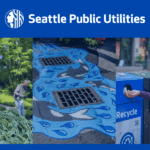
In Seattle, we ask customers not to use the numbers on packaging to determine if an item is recyclable or not. Here’s why.
Have you ever looked at the bottom of a plastic container or packaging and found a small number (usually 1-7) contained in triangle? You wouldn’t be alone if you thought those numbers were some coded way of knowing if an item should or shouldn’t be recycled. The truth is, those numbers have nothing to do with if an item can be recycled or not.
The numbers you find on many plastic items are what’s known as a Resin Identification Code (RIC) and tell processors what the package is made of. This system was developed in the 1980s by the Plastics Industry Association and they stand for different types of plastic. For example, a symbol with a “1” in the middle means an item is made of polyethylene terephthalate which can apply to single-use bottled drinks like a soda bottle (recyclable). In comparison, “7” stands for “Other” which is a fairly broad category and can be found on anything from large water bottles (recyclable) to DVDs (garbage).
The main thing to remember is that these numbers are in no way an indication of how you, as the consumer, should dispose of an item.
In Seattle, you may find several items with the same RIC number but they could have very different qualities that may contribute to how you should dispose of those items.
Instead of going by the numbers that you find on the packaging, we ask customers to focus on practical aspects of the items that they want to dispose of. For recycling, if an item falls into one of the “Top 5” products, then it’s likely recyclable.
Top 5 Recyclable Products
- Paper – office, newspaper, & magazines
- Cardboard – paperboard & corrugated boxes
- Plastic – bottles, tubs, and jugs – bottles, containers, tubs, & jugs
- Glass – bottles & jars
- Metal – aluminum, tin, & steel cans & scrap
In addition to these top 5 products, the recyclability of an item is also determined by the rigidity and the size. For example, flimsy plastics like the flexible trays found in cookie boxes are not rigid enough to be recycled in our system. We also need items to be at least three inches in diameter. Any smaller and they run the risk of interfering with and clogging our sorting mechanisms at our facilities. By recycling right, you are keeping contaminants out of the recycling stream which helps SPU make the most of these items, diverting more waste from landfills.
We understand that it can be confusing to know where an item should go. When in doubt, find out using our helpful Where Does It Go online tool.


